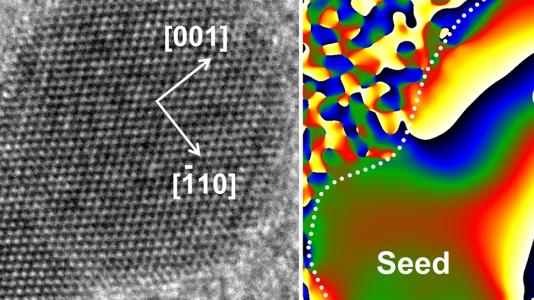
The nucleation and growth kinetics of multicomponent nanoparticles was probed with atomic resolution by Center for Nanoscale Materials (CNM) users from Illinois Institute of Technology together with the CNM Nanobio Interfaces Group and collaborators from the APS, CSE, University of Illinois at Chicago and the University of Illinois. An overgrowth of Au on metallic seed nanoparticle surfaces leads to a two-monolayer thick uniform shell that further transforms into uneven dumbbell like structures. Enormous stress in the core/shell lattice (equivalent to 2 GPa external pressure) eventually causes atomic layer slip along a particular crystallographic direction to accommodate the lattice mismatch, leading to anisotropic growth and formation of dumbbells.
Heterostructured nanoparticles can be used as catalysts and in advanced energy conversion and storage systems. Typically these nanoparticles are created from seeds of one material, on top of which another material is grown. This study shows that differences in the atomic arrangements of the two materials have a big impact on the shape of the resulting nanoparticle. The formation of a nanoparticle consisting of platinum and gold was observed by starting with a platinum seed and growing gold around it. Initially, the gold covered the platinum seed’s surface uniformly, creating a core-shell structure. However, as more gold was deposited, it began to grow unevenly, creating a dumbbell-like structure.
A simultaneous in situ small-angle and wide-angle X-ray scattering (SAXS, WAXS) study of nanodumbbell nucleation and growth was done in real time with atomic resolution. TEM and STEM-EDX, performed at CNM and UIC, respectively, confirmed that the cause of the dumbbell formation as lattice mismatch, in which the spacing between the atoms in the two materials doesn’t align. While the lattice mismatch is only fractions of a nanometer, the effect accumulates as layer after layer of gold forms on the platinum. The mismatch can be handled by the first two layers of gold atoms – creating the core-shell effect – but afterwards it proves too much to overcome. As the gold continues to accumulate on one side of the seed nanoparticle, small quantities slip down the side of the nanoparticle and create the dumbbell shape.
Lattice engineering at the interface provides a new tool for designing monolayer-thin efficient and selective catalysts.
S. Kwon et al., Heterogeneous nucleation and shape transformation of multicomponent metallic nanostructures, Nature Materials, 2014 (in press).